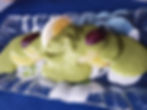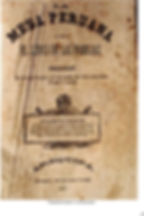The evolution of Ocopa arequipeña

Many people know of the Andean origins of the potato and so it might not be surprising that there are many dishes using the tuber as either the star or the supporting actor of a dish. You may also be aware that Peruvians love a good sauce. Some sauces have been made since before European contact. One such sauce is Ocopa arequipeña.
The main flavors of ocopa are ingredients that are indigenous to the Andes and South America: huacatay (Peruvian Black Mint), aji mirasol/amarillo (dried or fresh spicy pepper), and manî (peanut). In Incan times, the ocopa sauce got its name for the bag "ocopa" in which the paste of peppers, herbs, and peanuts, would be carried by the chasqui, or Incan messengers. The chasqui would run very long distances to deliver messages throughout the empire and would eat these bags of ocopa as a snack and for sustenance during their travels. When the Spanish arrived and brought other ingredients like onion, garlic, and dairy, the paste would eventually evolve into a sauce that today is used as an accompaniment to potatoes, mostly.
Well after the founding of the city of Arequipa (1521), national dishes and an emerging unique cuisine started forming in Peru. In 1867, La Mesa Peruana o sea El libro de las familias, was one of the first cookbooks ever published in the country. It has several editions, and in each of its editions (1867, 1895, 1994, 2009) you can watch the way recipes have been tweaked over time. It's interesting to note that this sauce, began as a paste that then had seafood and shellfish added it to give a depth of flavor, as well as greens and a bean called tarwi (or tarhui, as it appears in the book). It is not until the 1994 edition that we see what the modern recipe would look like (look on page 57 of linked article to see evolution of ocopa). It's then that we see vanilla cookies added to the sauce both as a sweetener and as a thickener.
While the lesser ingredients have changed over time, the main three indigenous ingredients of huacatay, aji mirasol/amarillo, and mani have remained the same. The name, too, has been almost the same since Incan times. Ocopa nods to its history as the chasqui's snack, but the "arequipeña" is a nod to the Peruvian black mint itself and the paste's/sauce's place origins. Huacatay, an herb in the same family as the marigold (you can tell by looking at its leaves!), is believed to not only have first start growing in Arequipa (the other gastronomic city of Peru) but the paste itself is believed to have been created there as well.
Today the herb can be found growing in all three main regions of Peru: the coast, the mountains, and the jungle.
Here you will find the more contemporary version of ocopa, served over room temperature or cold boiled potatoes, and most often eaten as an appetizer. It is on of my most favorite sauces of Peru. I hope you enjoy it! Buen provecho, amig@s!

Ocopa arequipeña - Serves 10-12
Ingredients
2 1/2 pounds gold potatoes, boiled, peeled, sliced in rounds (about 4-6 potatoes, depending on size)
1 large sprig of huacatay or 20-25 leaves
3 tablespoons toasted peanuts
1/2 small red onion, sliced
1 heaping tablespoons aji mirasol paste
1/2 tablespoon aji amarillo paste
2 cloves garlic, crushed
4 vanilla ("Maria") cookies
2 ounces queso fresco
1/2 can evaporated milk or equivalent of fresh milk
salt to taste
dash of pepper
2 eggs, hard-boiled, cut into fourths
4 black olives, pitted, sliced in quarters or halves
oil for sautéing
Preparation
Use a firm potato like gold or red for this dish. Boil with skin on to keep intact, then peel and slice into rounds. Place on serving dish and allow to cool.
In a sauté pan, heat oil and sauté onion until mostly translucent.
Add garlic and aji pastes. Sauté for 1 minute more.
Add peanuts. Sauté for 30 seconds more.
In a blender, food processor, or bullet, crumble the cookies and pour in milk.
To bullet, add sautéed veggies, queso fresco and huacatay.
Blend until smooth.
If you want a more vibrant green, add a tablespoon of cooked spinach and blend again.
It should feel thick but liquidy enough to pour over potatoes to easily coat them.
Pour ocopa over sliced, boiled potatoes to cover.
Decorate with hard boiled eggs and black olives.
Serve room temperature or cold.





















